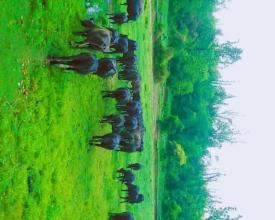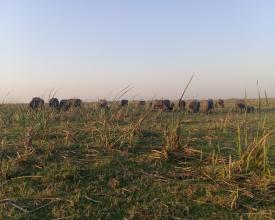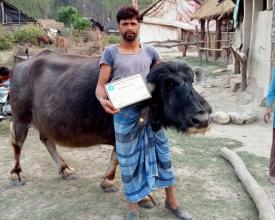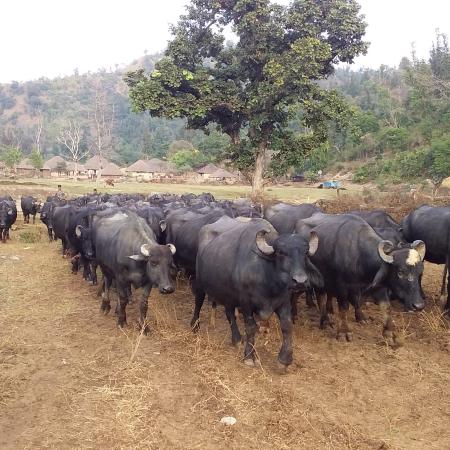
The Promise of a Sanghatan – How the Van Gujjars of Kunao Chaur is setting an example of coexistence, conservation and sustainable grassland management
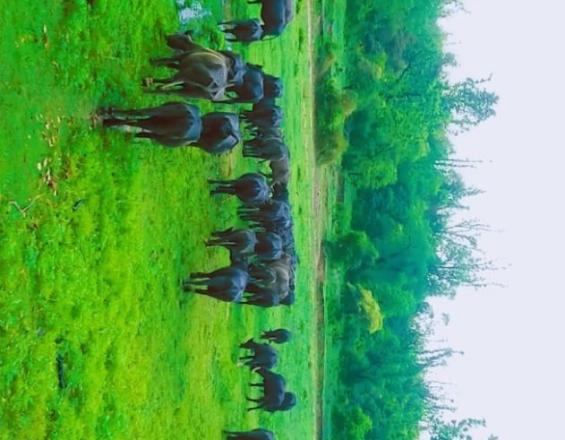
The present case study is prepared by the Van Gujjar Tribal Yuva Sanghatan (Hereinafter, Sanghatan) to highlight the measures undertaken by the Van Gujjar pastoralists engaging in breed conservation of the indigenous Gojri buffalo and protecting its pastoral landscape. The Sanghatan has chosen Kunaon Chaur, a grassland within Gohri range, Pauri Garhwal district, as a model site to throw light on how they utilize common property resources and contribute towards sustainable pasture land development. The recognition for the work of the Sanghatan in this landscape will encourage it to develop similar practices in other regions with Van Gujjars and the Gojri breed therein. The Sanghatan hopes its efforts on facilitating claims under the Forest Rights Act, 2006 and sustained conservation initiatives will bring positive reward in the near future.
Context
Challenges addressed
The primary challenge is the insecurity of community as well as individual land tenure pushing the Van Gujjars towards abandoning their pastoral livelihood and preferring a settled life. It is imperative that the traditional ecological knowledge is perpetuated to future generations to recognize their multiple uses in day-to-day life within forests. The challenge for the maintenance of the ecosystem, threatened by plantations of the Forest department and invasive species such as Lantana, requires sustained efforts from the Sanghatan. The Sanghatan is keen to inculcate cultural, ecological and community-driven initiatives to ensure the subsequent generations lead a sustainable life. It is hopeful that this activity of the Sanghatan will be incentivized by the Forest Department to ensure better management of the common pastures.
Location
Process
Summary of the process
The building blocks of the Forest Rights Act, 2006, sustainable pastoralism, traditional knowledge recognition, breed development and ecosystem restoration provide a multidimensional habitat management strategy towards an equitable land and pasture management solution
Building Blocks
Breed and Ecosystem conservation
The Van Gujjar Tribal Yuva Sanghatan has initiated several initiatives for the youth amongst them to turn towards education, both from schools as well as self—study groups which also initiate them towards traditional knowledge protection, bird watching, nature guiding, outdoor education through trails and games, handicrafts and cultural orientation of the community, to preserve their forest identities. The tribal identity is further promulgated in their sincere efforts to file for individual and community claims through the Forest Rights Act, 2006 as well as initiate community restoration drives, practices of herd mobility by empowering pastoral opportunities, prepare forest fire prevention squads and protect forests from poachers and cattle smugglers. They have currently undertaken a project to document the traditional knowledge and ecosystem benefits of 20 species of flora, which have food, medicinal, household or cultural uses for the community.
Enabling factors
The Van Gujjar Tribal Yuva Sanghatan has ensured members of the community do not engage in intermixing of breeds and promote the security and preservation of the indigenous Gojri breed within this landscape. The community is keen to safeguard its traditional knowledge, customary practices and cultural values. The Van Gujjars are also cultivating new ways to undertake conservation drives through initiatives like Saila Parv that ensure trees beneficial to the livestock are planted.
Lesson learned
It is hopeful that this activity of the Sanghatan will be incentivized by the Forest Department to ensure better management of the common pastures. The Sanghatan is willing to cooperate with all government and non-government institutions that are keen to propagate sustainable protection of the grassland through participative means to further its efforts in breed conservation and pasture management. It is also hopeful that the Sanghatan will soon form a cooperative of its own to ensure the breed finds viable means to develop and cherish with a complete agency of the Van Gujjars. Pastoralism as a livelihood needs a fillip through identifying such conservation strategies amidst humans, their livestock and other coexisting wild animals within the grassland. Several activities of the Sanghatan have ensured that coupled with the breed, several other species of fauna find utilization of the common property resource within which the Van Gujjars reside.
Livelihood strategies
The work of the Sanghatan is merely to empower the Van Gujjars within the Chaur by propagating techniques of breed conservation but are not directly involved with the day-to-day milk trade and profit. Nonetheless, the Sanghatan keeps a tab on the number of bulls, young calves, pregnant buffaloes, and those which produce milk on a monthly basis. Out of the 1528 buffaloes raised within the Chaur, around 475 buffaloes at present produce milk during this season. On a daily basis, a total of 700-800 litres of milk is collected in this season but this number rises to 1100-1200 litres in winters as it is the season when buffaloes give birth to young calves.
Enabling factors
The Sanghatan has demarcated the grassland into three areas namely Miya Bazaar, Nahar ke peeche compartment and Majhada (Islands on the floodplains of Ganges). All these three areas are utilized as per seasonal variation to ensure there is timely regeneration of grass and other vegetation.
Lesson learned
The Sanghatan is keen to promote the natural growth of forests in the region to ensure the indigenous Gojri breed need not have to rely upon purchased fodder from the market. With the use of such natural fodder, the Van Gujjars are able to maintain the nutritious value of their milk. The Sanghatan believes by adopting such sustainable processes for ensuring high quality of milk is enhancing the identity of their produce which has benefited several members to procure a reasonable and equitable market price for their commodity. The Sanghatan is keen to build on the goodwill of producing unadulterated and nutritious milk, unlike commercial dairy, which has additional health benefits for the populace consuming them.
Impacts
The activities of the Sanghatan have had a notable impact on the ecosystem and legal consciousness amongst the Van Gujjars. It has also helped in enhancing effective grassland management within Kunaon chaur through initiatives such as Saila Parv that ensure forest diversity. Their migratory and grazing patterns have enabled long-term viability for the ecosystem to flourish alongside wildlife. Their traditional and cultural knowledge is an added asset to efforts of conservation of habitats by national and international agencies. It is hopeful that the adoption of eco-literacy models will enhance sustainable new livelihoods whilst preserving the ecological benefits from continued transhuman pastoralism.
Beneficiaries
The primary beneficiaries of the sustainable land management programme are the Van Gujjars of Kunao Chaur and their livestock, along with wildlife, flora and policies of the Forest Department on silviculture and forest fire.
Sustainable Development Goals
Story

The Van Gujjars of Kunaon Chaud have developed specialized knowledge of local grasses and herbal remedies within the landscape. The role of women amongst the community with respect to possessing common knowledge of these herbal remedies for their livestock is worth mentioning. The indigenous curative system is used by the community when the characteristics of the following livestock diseases becomes evident like Khurpaka (Foot and mouth disease), Galghontu (Haemorrhagic septicaemia), Nakada/thanela (mastitis), Taku (epifemoral fever), Rinderpest and Surra. The diagnosis of these illnesses and the preparation of such indigenous prescriptions in which concoctions of roots and tubers, as well as a mixture of ash and whey, are administered to the afflicted animal. Apart from this several locals from the Chaur are aware of the illnesses caused by the consumption of poisonous weeds like Lantana, Cassia tora, Parthenium histerophorous, etc. These remedies are administered either in crushed or paste form, decoction, infusion, powder through nasal, ocular and ophthalmic routes. It is mixed with jaggery, bhusa (wheat husk) or fodder to remove the bitterness. The Van Gujjars knew the diagnosis of several illnesses and prepared the following herbal concoctions for lockjaw, cuts and wounds, abscess, dyspepsia and stomach ache by mixing natural ingredients such as alum, calcium carbonate, black pepper, ajwain and other local spices. The Maai is the expert with respect to such knowledge. Some of the herbal remedies which the Maai relies upon amidst the grassland include the lopping of trees such as Gutel, Beheda, Sein, Rehni, and Bakli.

